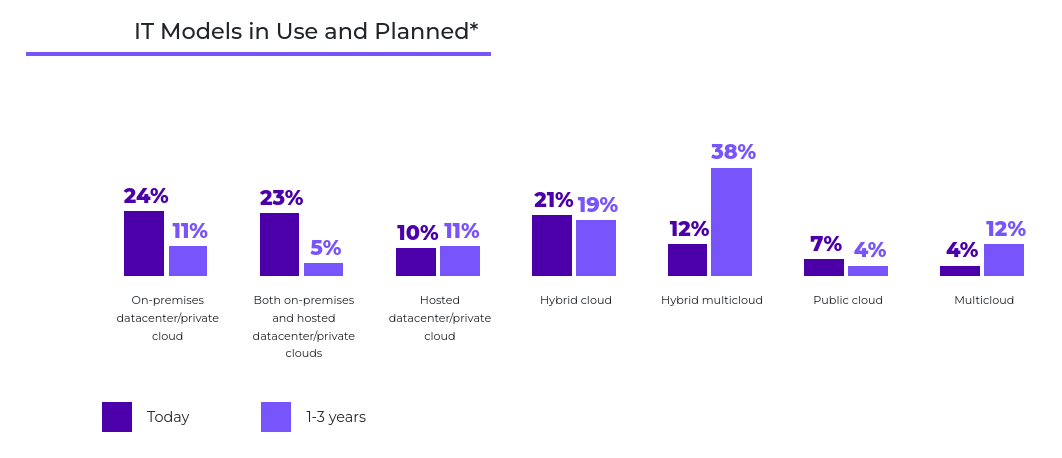To improve how they operate and interact with customers, businesses are embracing new data technologies and services. While Gartner projects that 51% of IT spending in key categories will shift to the cloud by 2025, many companies are modernizing their own data centers so they can better manage complexity and interoperate with a variety of services and infrastructures.
In the past few years, more are businesses are building hybrid multicloud IT operations, which is accelerating their ability to embrace cloud native innovations that are bringing new IT capabilities and efficiencies. This hybrid multicloud approach can help IT teams mitigate risks around data loss or downtime, adopt a data-centric and security-first mindsets, and leverage different strategies for managing total cost of ownership.
What Is Hybrid Cloud Digital Transformation?
Digital transformation refers to the adoption of digital technology by an organization as a replacement of non-digital items or services. At the IT infrastructure level, digital transformation can more specifically refer to the transition from on-premises data center hardware to a cloud-based platform.

Hybrid cloud digital transformation is the optimal path toward a digital future for many businesses. Operating in the hybrid cloud as a digital technology solution allows for greater flexibility and consistency compared to a solely private cloud approach.
Another key benefit of the hybrid cloud is compatibility. As a company begins to implement cloud native development practices, it becomes possible to move workloads seamlessly between on-premises private clouds to the public cloud and even to various locations in an expanded multicloud environment.
There are, however, certain risks that can threaten the process of digital transformation. For example, a lack of collaboration between business lines, executives and IT teams can result in halted or failed digital transformation altogether. It is necessary to overcome these risks and instead opt for hybrid cloud digital transformation.
The Role of the Hybrid Cloud in Digital Transformation
By definition, hybrid cloud is a cloud computing environment that combines elements of on-premises private clouds with third-party public clouds to grant more options in managing data, applications, and workloads. A common strategy when adopting this approach is to keep sensitive workloads in the private cloud while leveraging the public cloud for its efficient scalability when dealing with less sensitive data.
Traditional cloud architecture capitalizes on the concept of virtualization to maximize the amount of resources a company can draw from each individual server it owns. While it is possible to accomplish much with this type of architecture, it is not the same as true digital transformation through hybrid cloud adoption that enables an enterprise to lessen its own on-premises hardware footprint.
Hyperconverged infrastructure (HCI) can replace complex and expensive legacy infrastructure with a distributed platform that runs on industry-standard commodity servers. HCI converges compute, storage, storage networking and virtualization into a distributed platform, enabling enterprises to size their workloads precisely and to scale flexibly as needed.
HCI simplifies how IT teams manage their resources and allows them to use modern software and services such as Nutanix Cloud Clusters (NC2) to replicate and run their data center configurations in public clouds such as AWS or Azure. This combination makes it easier to move applications and data to and from different infrastures whenever the company wants to optimize performance and costs.
Expanding Digital Transformation Into the Multicloud
Multicloud refers to the approach of implementing two or more cloud platforms in one’s cloud service strategy. Adopting this approach is a natural progression for companies looking to expand their cloud operations, yielding such benefits as:
- Eliminating vendor lock-in
- Flexibility and scalability in workload storage options
- Freedom of choice in moving workloads between clouds based on suitability and pricing
Adopting a multicloud strategy early on, or setting a long-term goal of implementing a multicloud approach, can accelerate digital transformation. This is because operating in a multicloud setting mitigates downtime or data loss when a failure occurs at one location in the environment and because the inherent data sovereignty that is possible in the multicloud allows an enterprise to achieve optimal performance and minimal latency by locating processes closer to the end user.
These advantages of executing tasks from any one of many clouds in an ecosystem makes it easier for companies to overcome hiccups and hurdles that might otherwise arise in the digital transformation journey.
The flexibility and scalability that organizations can enjoy through deploying multiple clouds synergizes very well with the concept of the hybrid cloud. In a hybrid cloud digital transformation, decision-makers can take a “security-first” approach by keeping the most critical workloads contained to the private cloud while still reaping the benefits of multiple public clouds.
Of course, an organization that is already well on its way in the digital transformation journey can also expand their ongoing initiatives into the multicloud. Companies that value data centricity and that follow data-driven methodologies can easily extend such philosophies to each cloud in the network when operating on a platform that guarantees fully portable licenses across clouds.
Managing Total Cost of Ownership and Complexity with the Hybrid Multicloud
IT leaders consider total cost of ownership (TCO) when it comes to investing in new technologies. The impact that an investment has on company finances is rarely a simple matter of just the upfront price tag; there are long-term upkeep costs to consider as well. For a company with a history of owning and managing its own data center on-premises, the idea of a pay-as-you-go model in the cloud might initially be a hard pill to swallow.
Hybrid cloud and multicloud solutions can play a major role in an IT department’s efforts to improve cost-efficiency through pinpoint resource allocation and efficient application deployment. At the same time, the savings and efficiency made possible through the cloud can open doors to future growth and innovative problem-solving elsewhere in the enterprise.
Having an ideal cloud platform unifies and simplifies IT operations across different infrastructures and services, and helps businesses be more strategic about total cost of ownership decisions. Those companies that embraced digital transformation early have evolved their IT operations.
Between December 2022 and January 2023, almost all (99%) of the 1,450 IT decision-makers surveyed for the 2023 Nutanix Enterprise Cloud Index (ECI) said their organization moved one or more applications to a different IT infrastructure in the past year. The vast majority acknowledge that moving applications can get costly.
Sixty percent of IT teams in the ECI said they already leverage more than one IT infrastructure, whether it is a mix of private and public clouds, multiple public clouds, or an on-premises datacenter along with a hosted datacenter, with 38% of respondents expressing their desire to shift to the hybrid multicloud in one to three years. To manage the complexity of technology sprawl, 94% indicated that they would benefit from having a single, unified place to manage applications and data across their diverse environments.
Source: Enterprise Cloud Index 2023 by Nutanix
Figure displaying survey results of IT models currently in use and planned across the industry]
Embracing Cloud Native
Nearly all of the ECI respondents (97%) have begun using open-source Kubernetes orchestration (or containers), but they cite designing and configuring the underlying infrastructure, storage, and database services as among the top challenges they continue to face with their Kubernetes deployments. Containerization involves packaging software that contains all the necessary elements to run an operating system virtually. This allows organizations to run operating systems from anywhere - in a private datacenter, public cloud or even a personal laptop.
Hybrid cloud Kubernetes gives IT teams flexibility to manage these so-called cloud native workloads, so can then run across private and public cloud platforms. The Nutanix Kubernetes Engine is a production-ready Kubernetes solution with an emphasis on simplicity. NKE users can deploy clusters in minutes and enjoy a complete suite of Kubernetes features with no risk of vendor lock-in. In this way, Kubernetes contributes to digital transformation by providing scalable lifecycle management capabilities in the cloud.
A hybrid multicloud model that fully utilizes data-driven ideologies and Kubernetes solutions is one that can promise a favorable TCO and accelerated digital transformation. In an era of rampant data proliferation and digitization, hybrid cloud digital transformation is the path to simplicity and freedom for enterprise IT.
Editor’s note: Learn more about efficiency in digital transformation as well as cost-saving potential as a result of infrastructure transformation.
Michael Brenner is a keynote speaker, author, and CEO of Marketing Insider Group. Michael has written hundreds of articles on sites such as Forbes, Entrepreneur Magazine, and The Guardian and he speaks at dozens of leadership conferences each year covering topics such as marketing, leadership, technology, and business strategy.
© 2023 Nutanix, Inc. All rights reserved. For additional legal information, please go here.






